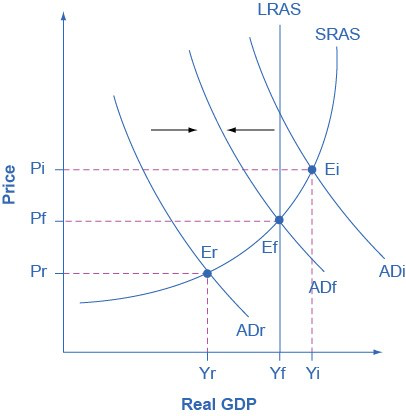Keynesian Approach to Unemployment and Inflation
What is the Keynesian Approach to Unemployment and Inflation?
- Marketing, Advertising, Sales & PR
- Accounting, Taxation, and Reporting
- Professionalism & Career Development
-
Law, Transactions, & Risk Management
Government, Legal System, Administrative Law, & Constitutional Law Legal Disputes - Civil & Criminal Law Agency Law HR, Employment, Labor, & Discrimination Business Entities, Corporate Governance & Ownership Business Transactions, Antitrust, & Securities Law Real Estate, Personal, & Intellectual Property Commercial Law: Contract, Payments, Security Interests, & Bankruptcy Consumer Protection Insurance & Risk Management Immigration Law Environmental Protection Law Inheritance, Estates, and Trusts
- Business Management & Operations
- Economics, Finance, & Analytics
What is the Keynesian Approach to Unemployment and Inflation?
Keynesian macroeconomics argues that the solution to a recession is expansionary fiscal policy, such as tax cuts to stimulate consumption and investment, or direct increases in government spending that would shift the aggregate demand curve to the right. For example, if aggregate demand was originally at ADr, so that the economy was in recession, the appropriate policy would be for government to shift aggregate demand to the right from ADr to ADf, where the economy would be at potential GDP and full employment.
Keynes noted that while it would be nice if the government could spend additional money on housing, roads, and other amenities, he also argued that if the government could not agree on how to spend money in practical ways, then it could spend in impractical ways. For example, Keynes suggested building monuments, like a modern equivalent of the Egyptian pyramids. He proposed that the government could bury money underground, and let mining companies start digging up the money again. These suggestions were slightly tongue-in-cheek, but their purpose was to emphasize that a Great Depression is no time to quibble over the specifics of government spending programs and tax cuts when the goal should be to pump up aggregate demand by enough to lift the economy to potential GDP.

If an economy is in recession, with an equilibrium at Er, then the Keynesian response would be to enact a policy to shift aggregate demand to the right from ADr toward ADf. If an economy is experiencing inflationary pressures with an equilibrium at Ei, then the Keynesian response would be to enact a policy response to shift aggregate demand to the left, from ADi toward ADf.
The other side of Keynesian policy occurs when the economy is operating above potential GDP. In this situation, unemployment is low, but inflationary rises in the price level are a concern. The Keynesian response would be contractionary fiscal policy, using tax increases or government spending cuts to shift AD to the left. The result would be downward pressure on the price level, but very little reduction in output or very little rise in unemployment. If aggregate demand was originally at ADi, so that the economy was experiencing inflationary rises in the price level, the appropriate policy would be for government to shift aggregate demand to the left, from ADi toward ADf, which reduces the pressure for a higher price level while the economy remains at full employment.
In the Keynesian economic model, too little aggregate demand brings unemployment and too much brings inflation. Thus, you can think of Keynesian economics as pursuing a “Goldilocks” level of aggregate demand: not too much, not too little, but looking for what is just right.
Related Topics
- Keynesian Perspective of Aggregate Demand
- Recessionary and Inflationary Gap
- Consumption Expenditure
- Investment Expenditure
- Government Spending in Aggregate Demand
- Net Exports in Aggregate Demand
- Keynesian Economic Analysis
- Wage and Price Stickiness
- Coordination Argument of Wage Stickiness
- What are Menu Costs
- Keynesian Assumptions in the Aggregate Demand and Aggregate Supply Model
- Macroeconomic Externality
- Expenditure Multiplier
- The Phillips Curve
- Keynesian Approach to Unemployment and Inflation
- Keynesian Perspective on Market Forces
- NeoClassical Economics
- Long Run Potential GDP
- Physical Capital Affects Productivity
- Potential GDP in the Aggregate Demand Aggregate Supply Model
- Prices are Flexible in the Long Run
- Keynesian and NeoClassical View of Long-Run Aggregate Supply and Demand
- Speed of Macroeconomic Adjustment of Wages and Prices
- Paradox of Rationality
- Rational Expectations Theory
- Shapley Value
- Mechanism Design Theory
- What is the Adaptive Expectations Theory
- Measure Inflation Expectations
- Neoclassical Phillips Curve Tradeoff
- Neoclassical View of Unemployment
- Neoclassical View of Recessions
- Keynesian vs Neoclassical Macroeconomic Policy Recommendations